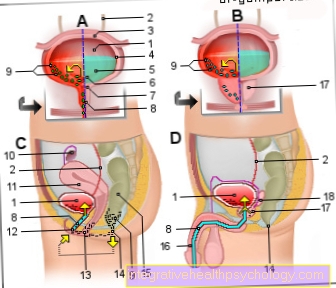How is the norovirus transmitted?
introduction
Along with rotavirus, the norovirus is the most common cause of viral diarrheal vomiting (gastroenteritis). It is characterized by a particularly high level of contagiousness (risk of infection): the transmission of just a few dozen pathogens from one sick person to another is sufficient for infection. With many other viral diseases, much larger amounts of virus particles are required for the disease to break out. This fact means that norovirus diseases often spread rapidly within a few days. In particular, in public facilities with close human contact, such as retirement homes or kindergartens, outbreaks can occur in this way, which affect a large proportion of the people housed and employed there.
Read more about the topic here: Norovirus - How Dangerous Is It?

How is the norovirus transmitted from person to person?
Many viruses can only be transmitted from person to person through direct contact. For example, sexual contact is a prerequisite for the transmission of the HIV virus that triggers AIDS, and the two people concerned must be very fond of each other for the transmission of herpes simplex viruses. In contrast, the norovirus can also be transmitted indirectly from person to person. In addition to the fact that the transmission of only a few dozen virus particles is sufficient for infection, the indirect transmission possibility is the second major reason for the recurring waves of norovirus disease.
The virus is excreted by infected people in their stool or vomit. Virus particles can then be inhaled by other people who then become ill. There is also a risk of infection from touching objects to which virus particles adhere (e.g. doorknobs, toilets, keyboards) and subsequent contact of the contaminated hands with the mouth. And finally, the virus can also be absorbed through the consumption of food that has previously come into contact with the sick.
It is important to note that infected people are not only contagious during symptoms, i.e. during diarrhea! Shortly before the onset of the symptoms, and especially up to two weeks after the disease has ended, they can excrete virus particles in the stool, which in turn can trigger the disease in other people.
Can the norovirus be transmitted through the air?
Yes! From a microbiological point of view, the transmission of the norovirus is a smear infection. This term describes that the virus is transmitted through direct contact with excretions from infected people or with objects that have come into contact with the excretions. However, virus particles can also get into the air in the form of aerosols (chemical term for liquid droplets dissolved in the air) and thus be inhaled. This is particularly important if, for example, when visiting a contaminated toilet, drops of water are whirled up and the norovirus is distributed in the air in this way.
Read more about the topic here: Smear infection
Can the virus live outside of humans?
Yes! The norovirus is extremely resistant and can survive outside humans for up to two weeks (some sources even assume a month!). Even extreme temperatures of below -20 ° C or above 60 ° C cannot harm it. For this reason, it is very important not only to avoid direct contact with infected people, but also e.g. To disinfect door handles or other frequently touched objects regularly in order to eliminate the noroviruses found there.
How can I prevent the transmission?
Adequate hygiene measures are essential to prevent transmission of the norovirus. Basic hygiene consists of regular thorough hand washing, which studies have shown to be even more effective than the use of disinfectant solutions. The latter are of course a useful addition to hand washing. If a wave of illness occurs in your environment, avoid close physical contact if possible - and not only with infected people, as symptom-free carriers can also transmit the virus (see below). This aspect includes, for example, avoiding hugs or, as far as possible, shaking hands.
Read more about the topic here: 6-step disinfection - Proper hand washing and disinfection
If someone in your household has had vomiting diarrhea, there is a high probability that they have a norovirus infection. In this case, common sense dictates avoiding direct contact with the infected as much as possible. If it becomes necessary to remove excretions from the infected person, be sure to use hygienic gloves and face masks and thoroughly disinfect the contaminated palms. In general, all surfaces that could have come into contact with the excretions, but also with the infected person themselves, should be disinfected - such as door handles or remote controls.
Please note: Up to two weeks after the symptoms of the disease have ended, the excretions of the person affected may contain virus particles that can lead to an infection - so continue the special hygiene measures at least for this period. Use single-use products to avoid spreading the virus further.
The infected person should use their own toiletries and towels. The latter as well as the infected person's clothes and bed linen should be washed at at least 60 ° C, as the norovirus is destroyed from this temperature. Regular and extensive ventilation also reduces the risk of the norovirus being transmitted through the air.
Read more about the topic here: How is norovirus infection treated?
Can the norovirus also be transmitted to animals?
According to the current state of knowledge, humans are the only so-called pathogen reservoir of the norovirus. This means that the virus only affects humans and cannot be transmitted to animals. The fact that animals cannot get the norovirus does not mean that an infected person can cuddle with the house cat or dog without hesitation: he could indeed transfer pathogens to the animal's fur, which then spreads it around the house and thus to the other residents of the Household transfers.
Can the norovirus be transmitted during the incubation phase, i.e. before symptoms develop?
The incubation phase, i.e. the period between infection and the onset of the disease, is very short with the norovirus and usually only lasts a few hours to a maximum of two days. The affected person is not yet contagious for most of the incubation phase. However, there can be a risk of infection about one to two hours before the onset of symptoms. For this reason, avoiding close contact with people who have recently come into contact with infected people and may therefore be in the incubation phase is one of the most important measures to prevent transmission.
Are you interested in this topic? Read our next article on this: How long is a norovirus infection contagious?
Can the norovirus be transmitted through kissing?
In theory, the norovirus can also be transmitted through kissing. Especially during the acute phase of the illness, you should therefore avoid kissing infected people - given the fact that the norovirus infection is a diarrheal vomiting, advice is certainly not too difficult to convey. After the symptoms of the disease have ceased, the risk of transmission when kissing decreases significantly.
However, there is still a residual risk, as those affected can still excrete virus particles up to two weeks after the disease has ended.Therefore, especially with inadequate toilet and hand hygiene, there is still the possibility of the virus being transmitted to the mouth area and, consequently, to another person when kissing.
Can the norovirus be transmitted through breast milk?
The norovirus has no way of getting into breast milk and therefore cannot be transmitted through it. The situation is different with breastfeeding as a whole: If the hygiene measures are not followed properly, an infected mother can contaminate her breast with her hands, for example, so that the child cannot ingest the pathogen through breast milk, but through breastfeeding.
If the necessary hygiene rules are observed, breastfeeding or breast milk even represents a protective factor for the child: With breast milk, certain sugar molecules are transferred that attach to the norovirus in the child's intestine and thus accelerate its excretion. For this reason, breast-fed children are less likely to develop norovirus than non-breast-fed children.
Can the norovirus be transmitted during pregnancy?
The norovirus cannot be transmitted to the unborn child and therefore does not pose a direct threat to the offspring. However, repeated diarrhea and vomiting can considerably weaken the mother's fluid and electrolyte balance, which in more severe cases can endanger the child .
It can therefore be said that if you have a norovirus infection during pregnancy, you should pay particular attention to an adequate balance of fluids and electrolytes, and in case of doubt (in the case of particularly pronounced or long-lasting diarrhea vomiting), medical help should be sought immediately.





























